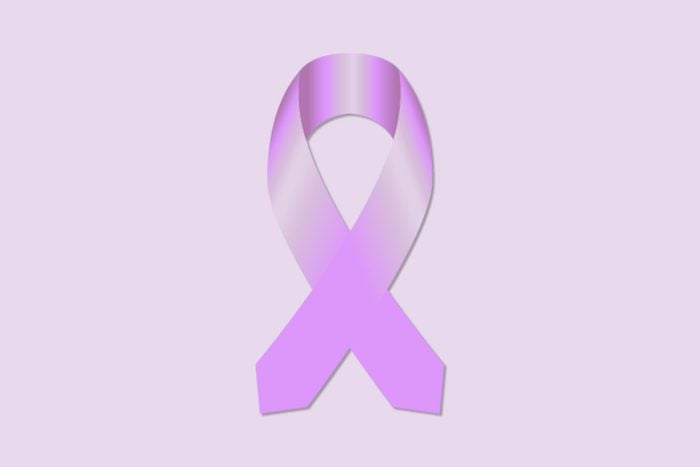
Lavender: All cancers
If you or a loved one has a rare form of cancer—or you don’t feel like broadcasting the type—the generic cancer ribbon color of choice is lavender, and there’s no special month attached to this color.
How many: One out of every three Americans will have some type of cancer during their lifetime, according to the American Cancer Society (ACS). Cancer is the second most common cause of death, after heart disease, and accounts for 25 percent of all deaths, they add.
Who’s most at risk: Anyone can get cancer but there are certain things that can increase your risk generally, including having a family history of cancer and lifestyle habits like smoking, drinking, a poor diet, and lack of exercise, reports the ACS.
Common symptoms: Symptoms depend on the type of cancer but if you find a concerning lump anywhere, have a sudden change in health, or experience unexplained symptoms see your doctor, according to the ACS. Make sure you know these 50 rampant cancer myths everyone needs to stop believing.
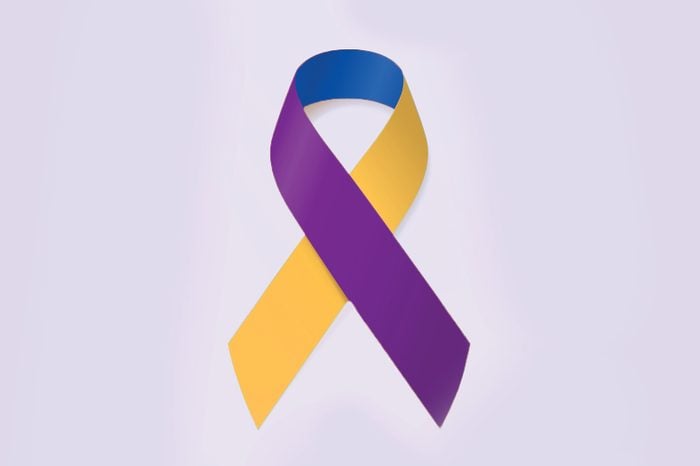
Marigold/Blue/Purple: Bladder Cancer (need new image)
[PHOTO: HERE’S A LINK TO HOW IT SHOULD LOOK: https://www.pinmart.com/bladder-cancer-ribbon-pin/]
The bladder cancer ribbon is marigold, blue and purple.
National awareness month: May
How many: About 2.4 percent of both men and women will get this type of cancer at some point in their lives, according to the National Cancer Institute (NCI).
Who’s most at risk: People older than 50, men, smokers, and those with a family history of the disease are at risk for bladder cancer, the ACS states.
Common symptoms: Blood in urine, pain during urination, and lower back pain are common bladder cancer symptoms, according to the ACS. For more, check out the 7 silent signs of bladder cancer.
Mortality: More than 75 percent of people with bladder cancer survive five years or longer, the ACS reports.
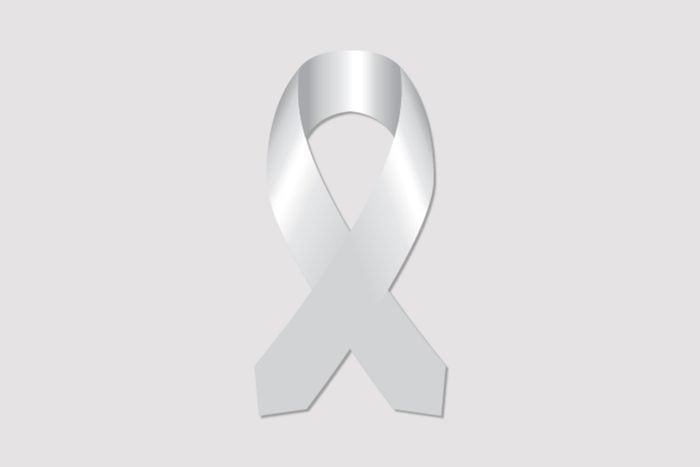
Gray: Brain cancer
Tumors found in the brain, spinal cord, or central nervous system are represented by this “gray matter” shade.
National awareness month: May
How many: About 0.6 percent of men and women will get this disease in their lifetime, according to the NCI.
Who’s most at risk: Genetics, weakened immune systems and exposure to radiation may play a role in brain cancers. Additional risk factors may be exposure to sugar substitute called aspartame, exposure to electromagnetic fields from power lines and/or infection with some viruses, but experts at the American Cancer Society agree that more research needs to be done into these and other possible risks for brain cancer factors.
Common symptoms: Headaches, nausea, vomiting, blurred vision, balance problems, personality changes and seizures are common brain cancer symptoms, according to the ACS.
Mortality: About 33 percent of patients survive five years or longer, the NCI reports.
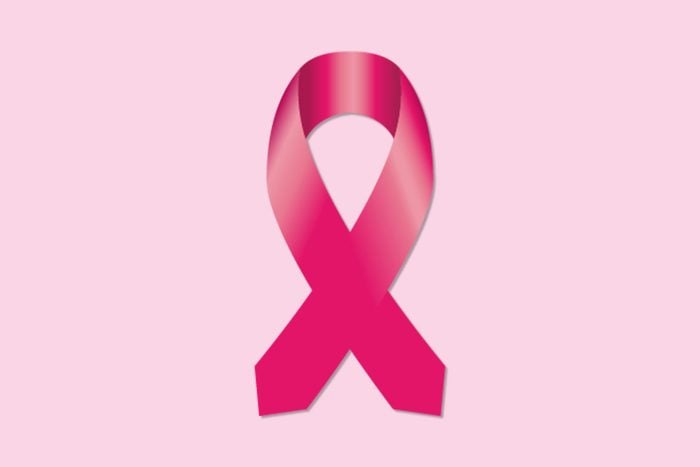
Pink: Female breast cancer
Perhaps the most familiar ribbon, the pink ribbon for breast cancer, can be found today on everything from water bottles to NFL uniforms.
National awareness month: October
How many: About 12.8 percent of women will get this disease in their lifetime, making it the most common cancer diagnosed in 2018.
Who’s most at risk: Women over 55 and those who carry certain genetic markers, which is why it is so important to discuss your family history with your doctor.
Common symptoms: Lump in the breast, changes in color or texture of the breast or nipple, or unusual discharge from the nipple. Watch for the 8 signs of breast cancer women ignore—besides a lump.
Mortality: Just shy of 90 percent of patients survive five years or longer, the NCI reports.
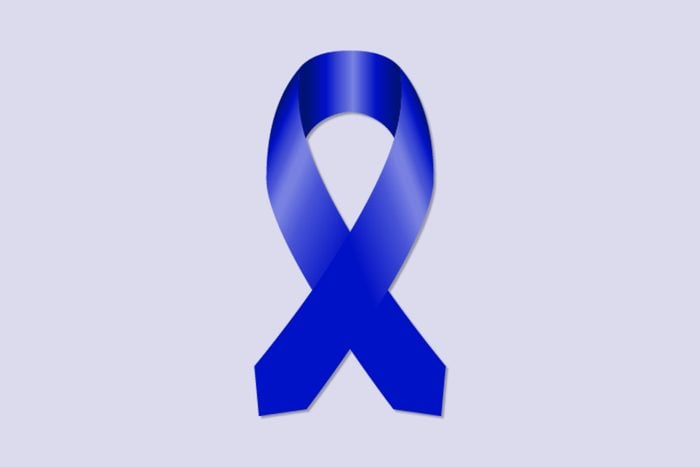
Dark blue: Colon and colorectal cancers
Colon and colorectal cancers are found in the large intestine and rectum.
National awareness month: March
How many: About(4.49 percent of men and 4.15 percent of women will develop colon or colorectal cancer in their lifetime, the ACS estimates.
Who’s most at risk: Colorectal cancer is much more common after age 50. Other risk factors include having inflammatory bowel disease, obesity, poor diet, and a family history of colon cancer, the ACS states. Here’s how to determine your personal risk of colon cancer.
Common symptoms: Blood in your stool, stomach cramps or stomach pain that doesn’t go away, and unintentional weight loss are common symptoms of colon cancer, according to the ACS.
Mortality: As many as 6 percent of patients survive five years or longer, the ACS states. Learn about the different stages of colon cancer.
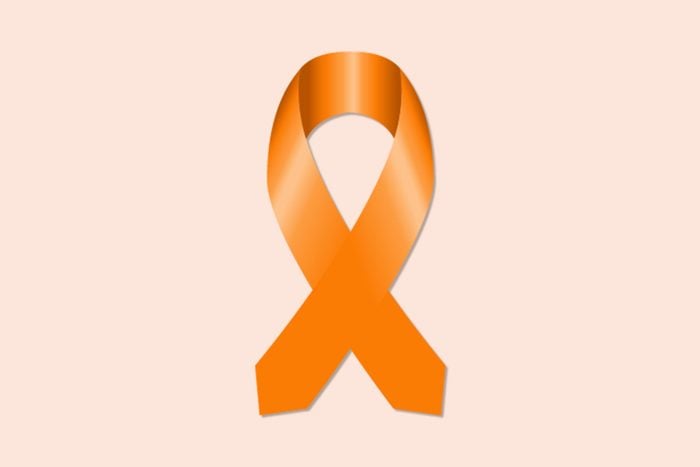
Orange: Kidney cancer
The orange ribbon stands for both kidney and renal cancers.
National awareness month: March
How many: About 1.7 percent of men and women will get this disease in their lifetime, the NCI estimates.
Who’s most at risk: Most people with kidney cancer are older. The average age at diagnosis is 64, with more men affected than women. Other risk factors include smoking, obesity, high blood pressure, workplace exposures to a type of metal known as cadmium, certain herbicides, and organic solvents, particularly trichloroethylene and a family history of kidney cancer, the ACS reports.
Common symptoms: Blood in your urine, a lump in your abdomen, low back pain, fatigue, fever, and weight loss.
Mortality: 75 percent of patients survive five years or longer. Find out why kidney cancer is one of the 7 most difficult cancers to screen for.

Orange: Leukemia
Orange also happens to be the shade that represents leukemia, a type of cancer that affects the bone marrow.
National awareness month: September
How many: About 1.6 percent of men and women will get this disease in their lifetime, according to the NCI.
Who’s most at risk: Most cases occur in people 50 years old or older, with white men being the highest risk group. Other risk factors include smoking, a family history of the disease, or being exposed to large amounts of radiation.
Common symptoms: Most often patients report no symptoms at all and the cancer is found through a routine blood test. However, some people report swollen lymph nodes, fatigue, and a general feeling of being unwell.
Mortality: Almost 63 percent of patients survive five years or longer.
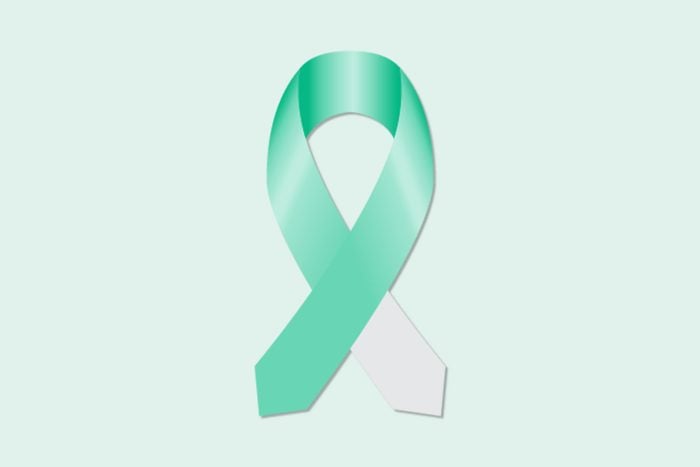
Teal and white: Cervical cancer
Cancer of the cervix, the opening to the uterus—along with a few other gynecological cancers—are represented by this pair of cancer ribbon colors.
National awareness month: January
How many: About 0.6 percent of women will get this disease in their lifetime, the NCI reports.
Who’s most at risk: Most cases occur in people aged 35 to 44, with Hispanic and black women having a slightly higher risk than other races. Risk factors include smoking, having multiple sexual partners, using hormonal birth control for five years or longer, and having more than three children. A major risk factor is HPV, which is why it’s so important for young adults to be vaccinated. And, yes, you can get the vaccine as an adult.
Common symptoms: Most often patients report no symptoms at all, especially in the early, most treatable stages of the disease. It’s usually discovered through a routine exam. In later stages, women report bleeding and unusual vaginal discharge. For more, check out these 8 subtle signs of cervical cancer.
Mortality: About 66 percent of patients survive five years or longer.
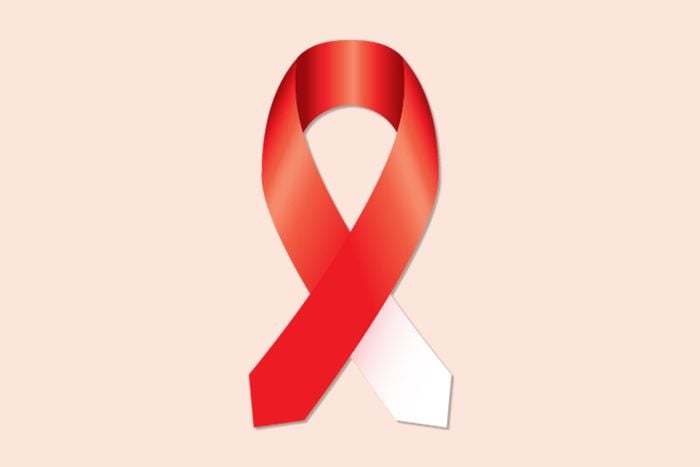
Red and white or burgundy and ivory: Head and neck cancers
These are the cancer ribbon colors for tumors of the head, neck, mouth, throat, and face.
National awareness month: April
How many: About 1.2 percent of men and women will get this disease in their lifetime, the NCI reports,
Who’s most at risk: Most cases occur in people 50 years old or older; men are three times more likely to get it than women. A major risk factor is HPV which is why it’s so important to get vaccinated. The other major risk factor is smoking or using tobacco products.
Common symptoms: Sores in your mouth that don’t heal, swelling in the jaw, trouble breathing or eating, and pain. Make sure you’re not ignoring these 6 early signs of throat cancer.
Mortality: Slightly more than 65 percent of patients survive five years or longer.
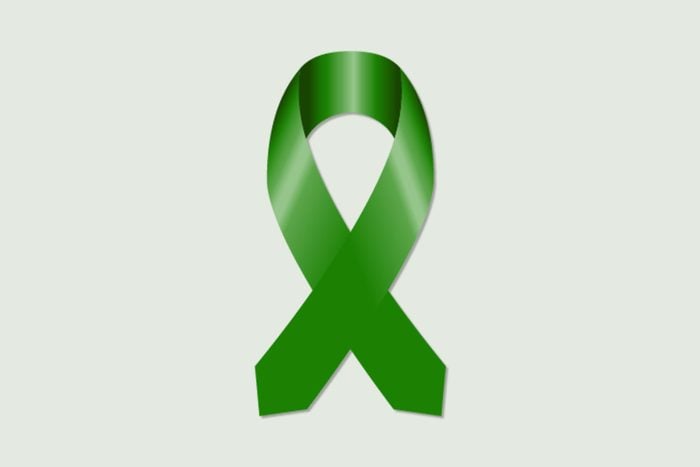
Emerald green: Liver
This bright green shade represents cancers of the liver and bile ducts.
National awareness month: October
How many: About 1 percent of men and women will get this disease in their lifetime, the NCI reports,
Who’s most at risk: Most cases occur in people 55 years old or older and men are three times more likely to get it than women, the ACS reports. Lifestyle factors like obesity, alcohol use, and diabetes are the biggest risk factors. The most common risk factor for liver cancer is long-term infection with hepatitis B virus (HBV) or hepatitis C virus (HCV).
Common symptoms: A lump or swelling in the abdomen, jaundice, easy bruising, fatigue, nausea, and unintentional weight loss. These are the 8 signs of liver cancer you should never ignore.
Mortality: Close to 18.5 percent of patients survive five years or longer, making it one of the deadliest cancers.
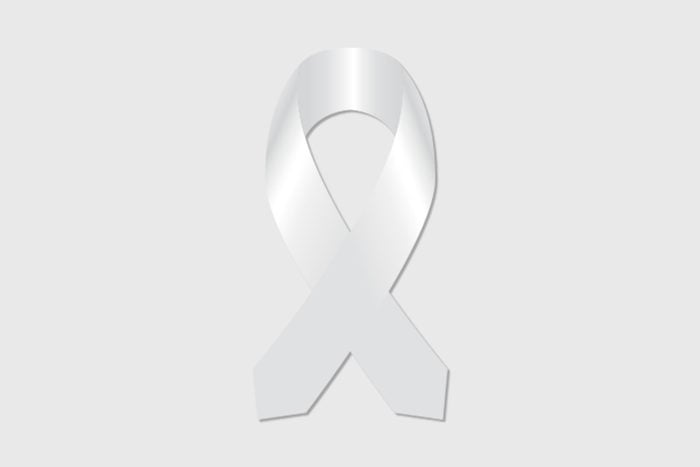
White: Lung
This pure hue represents lung and bronchial cancer, one of the top three most common cancers in the United States.
National awareness month: November
How many: About 6.3 percent of men and women will get this disease in their lifetime.
Who’s most at risk: Most cases of lung cancer occur in people aged 65 or older. The average age at diagnosis is about 70, according to the ACS. Smoking, including secondhand smoke, is a major risk factor. Exposure to other pollutants like radon and asbestos are the second most common cause. Note: Not all lung cancers are smoking-related, like this non-smoker who was diagnosed with lung cancer at 31.
Common symptoms: A cough that won’t go away, trouble breathing, coughing up blood, exhaustion, chest pain, and fatigue
Mortality: Close to 19.5 percent of patients survive five years or longer, making it one of the deadliest cancers, the NCI states.
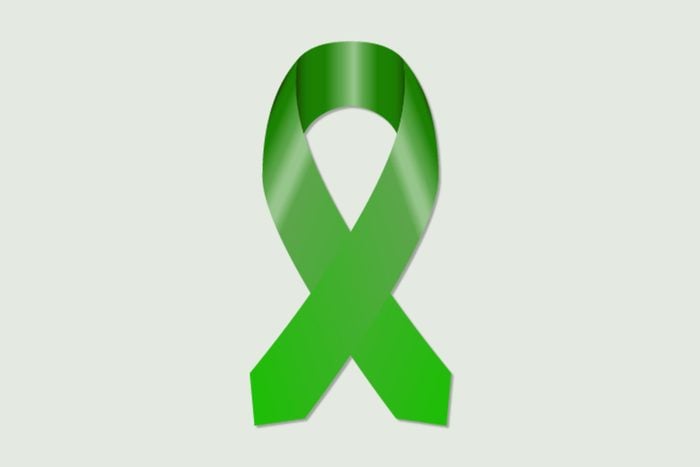
Lime green: Lymphoma
This citrusy shade represents Hodgkin and non-Hodgkin lymphomas, cancers that affect the lymph system, which includes the tissues and organs that produce, store, and carry white blood cells that fight infection.
National awareness month: September
How many: Approximately 2.2 percent of men and women will be diagnosed with non-Hodgkin lymphoma in their lifetime and approximately 0.2 percent of men and women will be diagnosed with Hodgkin lymphoma at some point during their lifetime, the NCI reports.
Who’s most at risk: While both forms strike all ages, Hodgkin lymphoma is most common in teens and young adults while non-Hodgkin lymphoma primarily occurs in older adults. Risk factors include a family history of the disease, exposure to radiation or pesticides, and certain viruses.
Common symptoms: Swollen lymph nodes, fever, night sweats, exhaustion.
Mortality: More than 86.5 percent of people with Hodgkin lymphoma survive five years or longer as do 72 percent of people diagnosed with non-Hodgkin lymphoma.
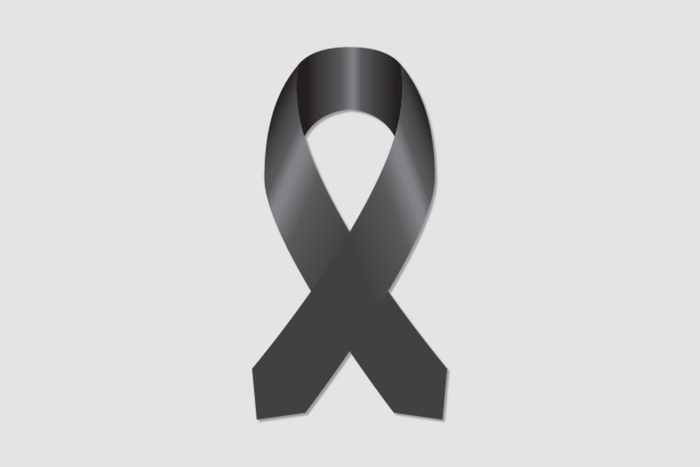
Black: Melanoma
A black ribbon symbol represents melanomas, cancers that affect the skin in even non-exposed areas like the scalp, nail beds, and eye. And that’s just one of the 51 things dermatologists want you to know about skin cancer.
National awareness month: May
How many: About 2.3 percent of men and women will get this disease in their lifetime, the NCI states.
Who’s most at risk: Sun exposure is the biggest risk factor for skin cancers, which is why doctors are so adamant about you wearing sunscreen. Having light skin, hair, or eyes increases your risk (although people with dark skin can definitely get it too), as does having a family history of the disease.
Common symptoms: A mole that meets the ABCDE criteria: Asymmetrical, irregular Border, uneven Color, Diameter larger than a pea, and Evolving or changing.
Mortality: Slightly more than 92 percent of patients survive five years or longer, making this one of the most treatable cancers, particularly if caught early.
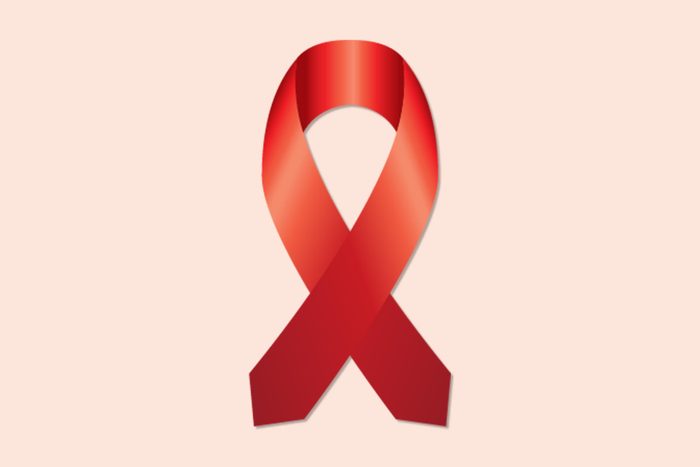
Burgundy: Myeloma
A burgundy colored ribbon represents the cancer myeloma, which attacks plasma cells and causes tumors in the bone marrow.
National awareness month: March
How many: About 0.8 percent of men and women will get this disease in their lifetime.
Who’s most at risk: Most cases occur in people 65 years old or older, with black men having the highest risk. In fact, the ACS reports that multiple myeloma is more than twice as common in African Americans than in white Americans. Obesity and family history are also risk factors for myeloma.
Common symptoms: It often doesn’t cause any symptoms at first and is usually diagnosed through a routine blood or urine test. Some patients report feeling deep “bone” pain, especially in the back and ribs, fatigue, fever, bruising easily, and frequent illness.
Mortality: More than 52 percent of patients survive five years or longer, the NCI reports.
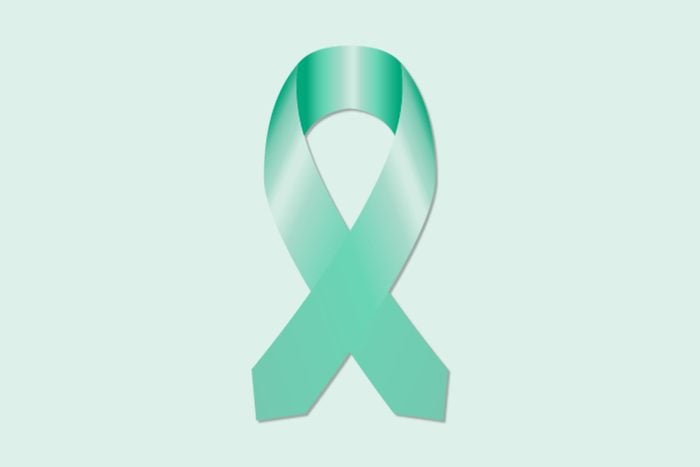
Teal: Ovarian
Similar to cervical cancer, ovarian cancer is found in the ovaries and is represented by teal cancer ribbon colors. These are the 15 common myths about ovarian cancer to be aware of.
National awareness month: September
How many: About 1.3 percent of women will get this disease in their lifetime, the NCI states
Who’s most at risk: Most ovarian cancers develop after menopause, and half of all ovarian cancers are found in women 63 years of age or older, the ACS states. It is more common in white women. The most significant risk factor is a family history of ovarian, breast, uterine, or colon cancer. Other risk factors include obesity, having problems getting pregnant and/or endometriosis.
Common symptoms: Bloating, belly pain, trouble eating or feeling full quickly and/or urinary symptoms such as(always feeling like you have to go or having to go often, the ACS states.
Mortality: More than 47.5 percent of patients survive five years or longer.
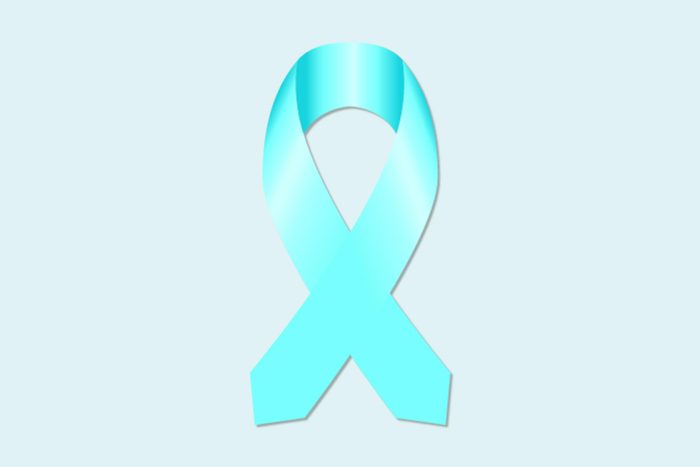
Light blue: Prostate
A pastel shade of blue represents cancers of the prostate, the organ that produces seminal fluid. These are the 8 facts about prostate cancer all men should know.
National awareness month: September
How many: About 11.6 percent of men will get this disease in their lifetime, making it the second most common cancer in men, after skin cancer, the NCI states.
Who’s most at risk: Black men over 55 are at the highest risk and are twice as likely to die of prostate cancer than men of other races. After age, the most significant risk factor is a strong family history of the disease.
Common symptoms: Difficult, painful, and/or frequent urination, blood in urine or semen, painful ejaculation, and back pain.
Mortality: Fully 98 percent of patients survive five years or longer, making it one of the most treatable cancers.
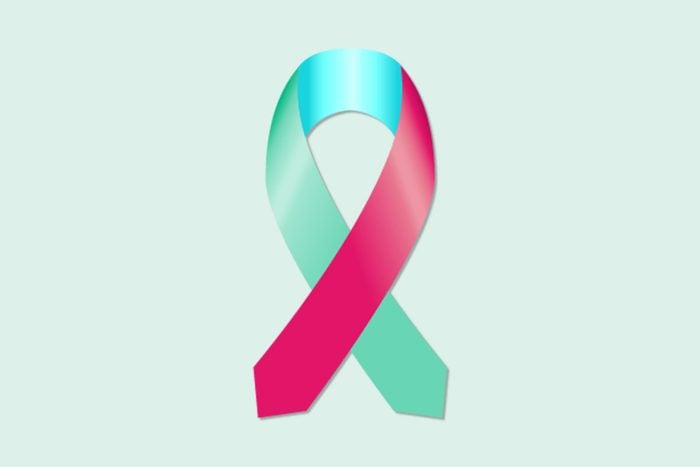
A blue, pink, and teal swirl: Thyroid
Cancer of the thyroid—a gland that controls hormones and many basic bodily functions—is represented by these three cancer ribbon colors.
National awareness month: September
How many: About 1.3 percent of women and men will get this disease in their lifetime, the NCI reports.
Who’s most at risk: Women are three times as likely to get it than men, the ACS notes. Risk tends to peak earlier for women than for men. Researchers aren’t entirely sure what causes thyroid cancers but exposure to some environmental toxins, like radiation and family history can increase your risk.
Common symptoms: A lump on the “Adam’s apple” on the front of the neck is the most common symptom. Other symptoms include trouble swallowing or breathing, and a raspy voice. Read up on these 6 sneaky signs of thyroid cancer.
Mortality: Slightly more than 98 percent of patients survive five years or longer, making it one of the most treatable cancers, the NCI reports.
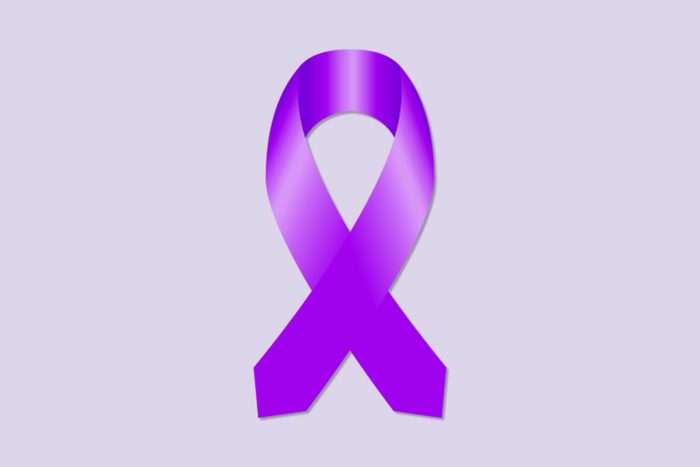
Dark purple: Pancreatic cancer
A deep purple cancer ribbon color represents cancers of the pancreas, an organ that creates the enzymes that help you digest your food.
National awareness month: November
How many: About 1.6 percent of women and men will get this disease in their lifetime, according to the NCI.
Who’s most at risk: Men and women aged 50 or older may be at greater risk for pancreatic cancer. Other risk factors include having pancreatitis, diabetes, or a family history of the disease. Obesity, smoking, and a poor diet can also increase your risk.
Common symptoms: This cancer often shows no symptoms at the beginning—meaning it often isn’t caught until it’s late-stage and difficult to treat. Other symptoms may include fatigue, jaundice, pain that radiates from your abdomen to your lower back, blood clots, and unintended weight loss.
Mortality: About 9.3 percent of patients survive five years or longer, making it one of the deadliest cancers, the NCI reports.

Light purple: Testicular cancer
This cancer, symbolized with a light purple cancer ribbon color, strikes the male organs that produce sperm and testosterone.
National awareness month: April
How many: About 0.4 percent of men will get this disease in their lifetime, the NCI states.
Who’s most at risk: The ACS reports that about half of testicular cancers occur in men between the ages of 20 and 34. Other risk factors include having an undescended testicle or other abnormality, and a family history of the disease.
Common symptoms: A lump in the testicle is the most common symptom. Others include a feeling of heaviness or pain in the scrotum, breast tenderness, and back pain. Don’t miss these 8 signs of testicular cancer you should never ignore.
Mortality: More than 95 percent of patients survive five years or longer, making it highly treatable.